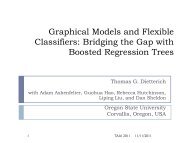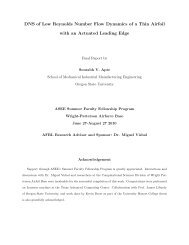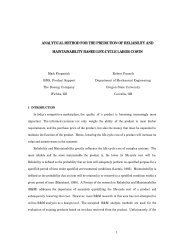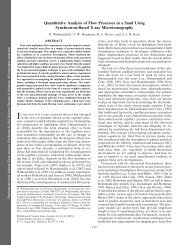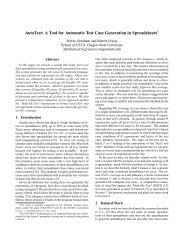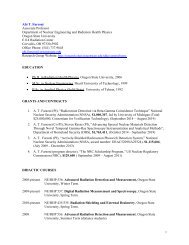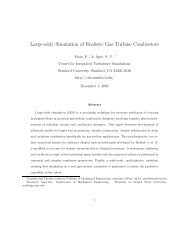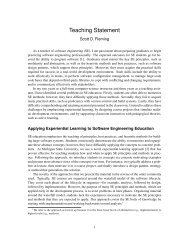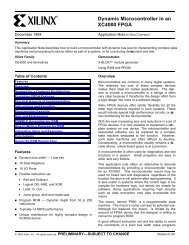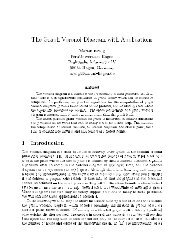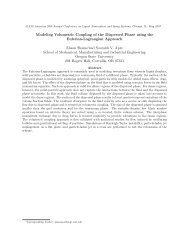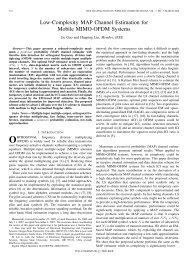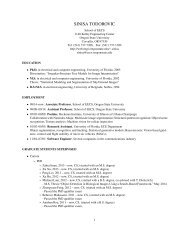Visualization of Diversity in Large Multivariate Data Sets
Visualization of Diversity in Large Multivariate Data Sets
Visualization of Diversity in Large Multivariate Data Sets
Create successful ePaper yourself
Turn your PDF publications into a flip-book with our unique Google optimized e-Paper software.
1062 IEEE TRANSACTIONS ON VISUALIZATION AND COMPUTER GRAPHICS, VOL. 16, NO. 6, NOVEMBER/DECEMBER 2010REFERENCES[1] A method for quantify<strong>in</strong>g and visualiz<strong>in</strong>g the diversity <strong>of</strong> qsar models.Journal <strong>of</strong> Molecular Graphics and Modell<strong>in</strong>g, 22(4):275 – 284, 2004.[2] T. Anderson. An <strong>in</strong>troduction to multivariate statistical analysis. WileyNew York, 1958.[3] A. Artero, M. de Oliveira, and H. Levkowitz. Uncover<strong>in</strong>g clusters <strong>in</strong>crowded parallel coord<strong>in</strong>ates visualizations. In Proceed<strong>in</strong>gs <strong>of</strong> the IEEESymposium on Information <strong>Visualization</strong>, pages 81–88. IEEE ComputerSociety, 2004.[4] H. Chern<strong>of</strong>f. The use <strong>of</strong> faces to represent po<strong>in</strong>ts <strong>in</strong> k-dimensional spacegraphically. Journal <strong>of</strong> the American Statistical Association, pages 361–368, 1973.[5] W. Cleveland and R. McGill. Graphical perception: Theory, experimentation,and application to the development <strong>of</strong> graphical methods. Journal<strong>of</strong> the American Statistical Association, 79(387):531–554, 1984.[6] W. Conover and R. Iman. Rank transformations as a bridge betweenparametric and nonparametric statistics. The American Statistician,35(3):124–129, 1981.[7] Y. Fua, M. Ward, and E. Rundenste<strong>in</strong>er. Hierarchical parallel coord<strong>in</strong>atesfor exploration <strong>of</strong> large datasets. In IEEE <strong>Visualization</strong>, volume 99, pages43–50, 1999.[8] D. Harrison and K. Kle<strong>in</strong>. What’s the difference? <strong>Diversity</strong> constructsas separation, variety, or disparity <strong>in</strong> organizations. Academy <strong>of</strong> ManagementReview, 32(4):1199, 2007.[9] H. Hauser, F. Ledermann, and H. Doleisch. Angular brush<strong>in</strong>g <strong>of</strong> extendedparallel coord<strong>in</strong>ates. In Proceed<strong>in</strong>gs <strong>of</strong> the IEEE Symposium on Information<strong>Visualization</strong>, pages 127–130, 2002.[10] S. Hurlbert. The nonconcept <strong>of</strong> species diversity: a critique and alternativeparameters. Ecology, 52(4):577–586, 1971.[11] A. Inselberg. Multidimensional detective. In IEEE Symposium on Information<strong>Visualization</strong>, pages 100–107, 1997.[12] A. Inselberg and B. Dimsdale. Parallel coord<strong>in</strong>ates: a tool for visualiz<strong>in</strong>gmulti-dimensional geometry. In Proceed<strong>in</strong>gs <strong>of</strong> the 1st conference on<strong>Visualization</strong>’90, page 378. IEEE Computer Society Press, 1990.[13] B. Johnson and B. Shneiderman. Tree-maps: A space-fill<strong>in</strong>g approach tothe visualization <strong>of</strong> hierarchical <strong>in</strong>formation structures. In Proceed<strong>in</strong>gs <strong>of</strong>the 2nd conference on <strong>Visualization</strong>’91, pages 284–291. IEEE ComputerSociety Press Los Alamitos, CA, USA, 1991.[14] E. Kandogan. Visualiz<strong>in</strong>g multi-dimensional clusters, trends, and outliersus<strong>in</strong>g star coord<strong>in</strong>ates. In Proceed<strong>in</strong>gs <strong>of</strong> the seventh ACM SIGKDD <strong>in</strong>ternationalconference on Knowledge discovery and data m<strong>in</strong><strong>in</strong>g, pages107–116. ACM New York, NY, USA, 2001.[15] D. Keim. Visual <strong>Data</strong>base Exploration Techniques. In Proc. TutorialInt. Conf. on Knowledge Discovery & <strong>Data</strong> M<strong>in</strong><strong>in</strong>g, Newport Beach, CA,1997.[16] D. Keim. Information visualization and visual data m<strong>in</strong><strong>in</strong>g. IEEE transactionson <strong>Visualization</strong> and Computer Graphics, pages 1–8, 2002.[17] R. Kosara, F. Bendix, and H. Hauser. Parallel sets: Interactive explorationand visual analysis <strong>of</strong> categorical data. IEEE Transactions on <strong>Visualization</strong>and Computer Graphics, 12(4):558–568, 2006.[18] C. Krebs. Ecological methodology. Harper & Row New York, 1989.[19] D. Lau and J. Murnighan. Demographic diversity and faultl<strong>in</strong>es: Thecompositional dynamics <strong>of</strong> organizational groups. Academy <strong>of</strong> ManagementReview, 23(2):325–340, 1998.[20] J. LeBlanc, M. Ward, and N. Wittels. Explor<strong>in</strong>g n-dimensional databases.In Proceed<strong>in</strong>gs <strong>of</strong> the 1st conference on <strong>Visualization</strong>’90, page 237. IEEEComputer Society Press, 1990.[21] D. MacAdam. Visual sensitivities to color differences <strong>in</strong> daylight. J. Opt.Soc. Am, 32:247–273, 1942.[22] J. Mack<strong>in</strong>lay. Automat<strong>in</strong>g the design <strong>of</strong> graphical presentations <strong>of</strong> relational<strong>in</strong>formation. ACM Transactions on Graphics (TOG), 5(2):141,1986.[23] A. Magurran. Measur<strong>in</strong>g biological diversity. Wiley-Blackwell, 2003.[24] J. Miller. Spatial and temporal distribution and abundance <strong>of</strong> moths<strong>in</strong> the Andrews Experimental Forest. http://andrewsforest.oregonstate.edu/data/abstract.cfm?dbcode=SA015,2005.[25] J. Pearlman, P. Rhe<strong>in</strong>gans, and M. des Jard<strong>in</strong>s. Visualiz<strong>in</strong>g diversity anddepth over a set <strong>of</strong> objects. IEEE Computer Graphics and Applications,pages 35–45, 2007.[26] W. Peng, M. Ward, and E. Rundenste<strong>in</strong>er. Clutter reduction <strong>in</strong> multidimensionaldata visualization us<strong>in</strong>g dimension reorder<strong>in</strong>g. In Proceed<strong>in</strong>gs<strong>of</strong> the IEEE Symposium on Information <strong>Visualization</strong>, pages 89–96.IEEE Computer Society, 2004.[27] E. Pielou. Ecological diversity. Wiley New York, 1975.[28] C. Plaisant, B. Shneiderman, K. Doan, and T. Bruns. Interface and dataarchitecture for query preview <strong>in</strong> networked <strong>in</strong>formation systems. ACMTrans. Inf. Syst., 17(3):320–341, 1999.[29] J. Seo and B. Shneiderman. A rank-by-feature framework for <strong>in</strong>teractiveexploration <strong>of</strong> multidimensional data. Information <strong>Visualization</strong>,4(2):96–113, 2005.[30] C. Shannon and W. Weaver. The mathematical theory <strong>of</strong> <strong>in</strong>formation.Urbana: University <strong>of</strong> Ill<strong>in</strong>ois Press, 97, 1949.[31] B. Shneiderman. Tree visualization with tree-maps: 2-d space-fill<strong>in</strong>g approach.ACM Transactions on graphics (TOG), 11(1):92–99, 1992.[32] B. Shneiderman. The eyes have it: A task by data type taxonomy for<strong>in</strong>formation visualizations. In IEEE Visual Languages, pages 336–343,1996.[33] J. Stasko, R. Catrambone, M. Guzdial, and K. McDonald. An evaluation<strong>of</strong> space-fill<strong>in</strong>g <strong>in</strong>formation visualizations for depict<strong>in</strong>g hierarchicalstructures. International Journal <strong>of</strong> Human Computer Studies,53(5):663–694, 2000.[34] W. Torgerson. Multidimensional scal<strong>in</strong>g: I. Theory and method. Psychometrika,17(4):401–419, 1952.[35] A. Treisman. Preattentive process<strong>in</strong>g <strong>in</strong> vision. In Papers from the secondworkshop Vol. 13 on Human and Mach<strong>in</strong>e Vision II, page 334. AcademicPress Pr<strong>of</strong>essional, Inc., 1986.[36] C. Ware. Information visualization: perception for design. Morgan Kaufmann,2004.[37] R. Whittaker. Dom<strong>in</strong>ance and <strong>Diversity</strong> <strong>in</strong> Land Plant Communities:Numerical relations <strong>of</strong> species express the importance <strong>of</strong> competition <strong>in</strong>community function and evolution. Science, 147(3655):250, 1965.[38] F. Young and R. Hamer. Multidimensional scal<strong>in</strong>g: History, theory, andapplications. L. Erlbaum Associates Hillsdale, NJ, 1987.



